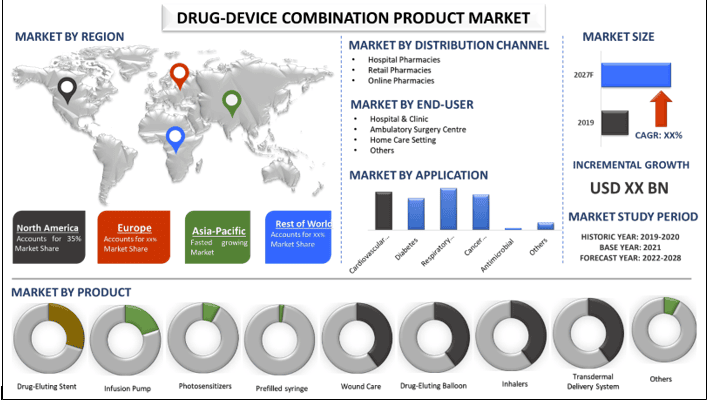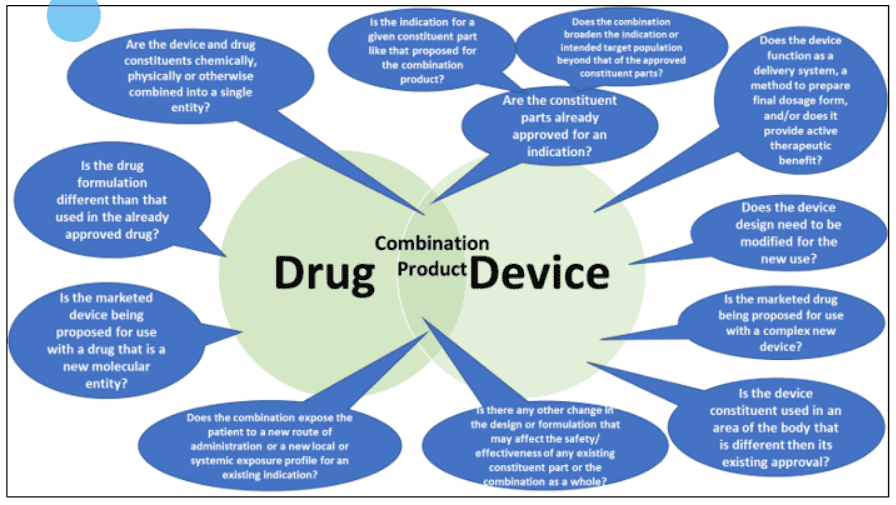 药物-器械组合产品为医疗产品开发、监管审批和商业合作引入了新的动态,为新一代组合产品的开发提供了宝贵的经验。例如,Boston Scientific 于 2019 年 11 月宣布在血管介入进展 (VIVA) 会议上举行的单独的最新临床试验演示中,推出了外周药物洗脱产品组合中的两种器械。展示的产品是“Ranger 药物涂层球囊 (DCB)”以及“Eluvia 药物洗脱血管支架 (DES)”,该支架在 DCB 或 DES 的美国关键试验中,显示了迄今为止报告的治疗股腘疾病的最高主要通畅率。此外,癌症、心脏病、多发性硬化症和糖尿病等慢性疾病病例的激增正在加速该市场的增长。根据世界卫生组织 (WHO) 的数据,2020 年,慢性疾病病例占全球所有死亡人数的近四分之三,其中 71% 的死亡是由于缺血性心脏病 (IHD),75% 的死亡是由于中风,70% 的死亡是由于糖尿病发生在发展中国家。
药物-器械组合产品为医疗产品开发、监管审批和商业合作引入了新的动态,为新一代组合产品的开发提供了宝贵的经验。例如,Boston Scientific 于 2019 年 11 月宣布在血管介入进展 (VIVA) 会议上举行的单独的最新临床试验演示中,推出了外周药物洗脱产品组合中的两种器械。展示的产品是“Ranger 药物涂层球囊 (DCB)”以及“Eluvia 药物洗脱血管支架 (DES)”,该支架在 DCB 或 DES 的美国关键试验中,显示了迄今为止报告的治疗股腘疾病的最高主要通畅率。此外,癌症、心脏病、多发性硬化症和糖尿病等慢性疾病病例的激增正在加速该市场的增长。根据世界卫生组织 (WHO) 的数据,2020 年,慢性疾病病例占全球所有死亡人数的近四分之三,其中 71% 的死亡是由于缺血性心脏病 (IHD),75% 的死亡是由于中风,70% 的死亡是由于糖尿病发生在发展中国家。
此外,先进产品开发投资的增加以及持续的研究活动也在加速对药物-器械组合产品日益增长的需求。例如,多功能经皮共面能量传输 (CET) 系统的发明者“Leviticus Cardio”与“Jarvik Heart”合作,获得了以色列-美国双边工业研究与开发 (BIRD) 基金会提供的 950,000 美元的资金。此外,器械中不断涌现的技术创新也在推动全球药物-器械组合产品的增长。例如,FDA 于 2020 年 9 月批准“Trelegy Ellipta”作为美国首个每日一次的单吸入器三联疗法,用于治疗哮喘和 COPD。此外,COVID-19 大流行以不同的方式影响了所有行业。由于 COVID-19 大流行,私营医疗保健部门受到了严重阻碍。许多临床试验在大流行期间被暂停。为了重新启动临床试验,美国食品和药物管理局 (FDA) 于 2020 年 3 月在 COVID-19 紧急情况下发布了一些指南。这些指南于 2020 年 7 月 2 日进一步更新。这些指南包括一般考虑事项,以帮助赞助商和研究人员,从而确保检测成员的安全以及在 COVID-19 紧急情况期间遵守良好的临床实践。
使用一种或多种目前上市的组分开发组合产品的注意事项

Medtronic PLC、Abbott Laboratories、Smith & Nephew plc、Boston Scientific Corporation、GlaxoSmithKline plc、Becton Dickinson and Company、Johnson & Johnson、Novartis AG、Bayer AG 和 Baxter International, Inc 是全球药物-器械组合产品市场中的一些主要参与者。这些参与者已经进行了多次并购以及合作,以向客户提供高科技和创新产品。
报告中呈现的见解
“在产品中,吸入器细分市场占据主要份额”
根据产品,市场分为药物洗脱支架、输液泵、光敏剂、预填充注射器、伤口护理组合产品、药物洗脱球囊、吸入器、透皮给药系统和其他。2020 年,吸入器细分市场占据主导地位。预计呼吸系统疾病患者数量的不断增长将推动分析期间的市场发展。
“在应用中,呼吸系统问题细分市场在 2020 年占据主导地位”
根据应用,市场分为心血管疾病、糖尿病、呼吸系统问题、癌症治疗、抗菌应用和其他。由于对新型药物-器械组合产品的认识不断提高,呼吸系统问题细分市场在 2020 年占据了主要的收入份额。
“在分销渠道中,医院药房细分市场在 2020 年占据了约 54% 的份额”
根据分销渠道,市场分为医院药房、零售药房和在线药房。医院药房细分市场在 2020 年占据了主要的收入份额。由于大多数疾病都在医院治愈或治疗,因此预计该细分市场将在整个预测期内保持其主导地位。
“在最终用户中,医院和诊所细分市场占据主要份额”
根据最终用户,市场分为医院和诊所、流动手术中心、家庭护理场所和其他。预计医院和诊所细分市场将出现有利可图的增长。该细分市场在 2020 年创造了 61,603.2 百万美元的收入。
“北美是药物-器械组合产品市场的最大市场之一”
为了更好地了解药物-器械组合产品市场的市场动态,我们对全球不同地区进行了详细分析,包括北美(美国、加拿大、北美其他地区)、欧洲(英国、德国、法国、意大利、西班牙、欧洲其他地区)、亚太地区(中国、日本、印度、澳大利亚、亚太地区其他地区)和世界其他地区。北美是药物-器械组合产品行业的主要市场,2020 年创造了 39,729.6 百万美元的收入。预计亚太地区在分析期间将实现 6.86% 的复合年增长率。
购买本报告的理由:
- 该研究包括经过认证的主要行业专家验证的市场规模和预测分析
- 该报告简要概述了一目了然的整体行业表现
- 该报告深入分析了主要行业同行,主要关注关键业务财务、产品组合、扩张策略和最新发展
- 详细考察了行业中存在的驱动因素、限制因素、关键趋势和机遇
- 该研究全面涵盖了跨不同细分市场的市场
- 深入的行业区域/国家层面分析
定制选项:
药物-器械组合产品市场可以根据需求或任何其他细分市场进一步定制。除此之外,UMI 了解到您可能有自己的业务需求,因此请随时与我们联系,以获取完全符合您要求的报告。
目录
分析历史市场、评估当前市场以及预测全球药物-器械组合产品市场的未来市场是创建和分析全球主要区域不同细分市场中药物-器械组合产品采用情况的三个主要步骤。进行了详尽的二级研究,以收集历史市场数据并评估当前市场规模。其次,为了验证这些见解,考虑了许多发现和假设。此外,还与药物-器械组合产品行业价值链中的行业专家进行了详尽的初步访谈。通过初步访谈对市场数据进行假设和验证后,我们采用了自上而下/自下而上的方法来预测完整的市场规模。此后,采用市场细分和数据三角剖分方法来评估和分析行业相关细分市场和子细分市场的市场规模,详细方法如下:
历史市场规模分析
步骤1:深入研究二级来源:
进行了详细的二级研究,通过公司内部来源(如年度报告和财务报表、业绩演示文稿、新闻稿等)以及外部来源(包括期刊、新闻和文章、政府出版物、竞争对手出版物、行业报告、第三方数据库和其他可信出版物)来获取药物-器械组合产品的历史市场规模。
步骤2:市场细分:
在获得药物-器械组合产品市场的历史市场规模后,我们进行了详细的二级分析,以收集主要区域不同细分市场的历史市场见解和份额。报告中包含的主要细分市场包括产品、应用、流程、分销渠道和最终用户。此外,还进行了国家层面的分析,以评估每个地区药物-器械组合产品的总体采用情况。
步骤3:因素分析:
在获得不同细分市场和子细分市场的历史市场规模后,我们进行了详细的因素分析,以评估药物-器械组合产品的当前市场规模。此外,我们使用因变量和自变量进行因素分析,例如慢性疾病患者的日益普及以及家庭保健市场的兴起将增加对药物-器械组合产品的需求。考虑到全球药物-器械组合产品行业中的顶级合作关系、并购、业务扩张和产品发布,对需求和供应侧情景进行了全面分析。
当前市场规模评估与预测
当前市场规模:基于上述3个步骤的可行见解,我们得出了当前的市场规模、药物-器械组合产品市场中的主要参与者以及细分市场的市场份额。所有需要的百分比份额拆分和市场细分均使用上述二级方法确定,并通过初步访谈进行了验证。
评估与预测:对于市场评估和预测,权重被分配给不同的因素,包括利益相关者的驱动因素和趋势、限制和机会。在分析了这些因素后,应用了相关的预测技术,即自上而下/自下而上的方法,以得出全球主要市场中不同细分市场和子细分市场到2027年的市场预测。用于评估市场规模的研究方法包括:
- 该行业的市场规模,以价值(美元)和国内主要市场中药物-器械组合产品的采用率来衡量
- 所有百分比份额、拆分和市场细分市场和子细分市场的细分
- 药物-器械组合产品市场中的主要参与者,以提供的服务来衡量。此外,这些参与者为在快速增长的市场中竞争而采取的增长策略
市场规模和份额验证
初步研究:与主要区域的关键意见领袖(KOL),包括顶级管理人员(CXO/VP、销售主管、营销主管、运营主管和区域主管、国家主管等)进行了深入访谈。然后对初步研究结果进行了总结,并进行了统计分析以证明既定假设。来自初步研究的输入与二级研究结果相结合,从而将信息转化为可行的见解。
不同地区的主要参与者比例
市场工程
采用数据三角剖分技术来完成整体市场评估,并得出药物-器械组合产品市场中每个细分市场和子细分市场的精确统计数据。在研究了药物-器械组合产品市场的产品、应用、分销渠道和最终用户领域的各种参数和趋势后,将数据分成几个细分市场和子细分市场。
药物-器械组合产品市场研究的主要目标
研究中指出了药物-器械组合产品当前和未来的市场趋势。投资者可以从研究中进行的定性和定量分析中获得战略见解,以作为其投资判断的依据。当前和未来的市场趋势决定了区域层面市场的总体吸引力,为行业参与者提供了一个利用未开发市场以获得先发优势的平台。研究的其他定量目标包括:
- 分析药物-器械组合产品当前和预测的市场规模,以价值(美元)来衡量。此外,分析不同细分市场和子细分市场的当前和预测的市场规模
- 研究中的细分市场包括产品、应用、流程、设计和最终用户领域
- 定义和分析药物-器械组合产品行业的监管框架
- 分析与各种中介机构相关的价值链,以及分析行业的客户和竞争对手行为
- 分析主要地区药物-器械组合产品市场当前和预测的市场规模
- 报告中研究的主要地区包括北美(美国和加拿大)、欧洲(德国、法国、意大利、西班牙和英国)、亚太地区(中国、日本、印度和澳大利亚)以及世界其他地区
- 药物-器械组合产品市场的公司概况以及市场参与者为在快速增长的市场中维持而采取的增长策略
- 深入分析该行业的区域层面
相关 报告
购买此商品的客户也购买了











